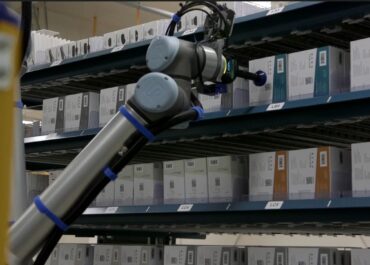There is this recurring theme on how smart technologies will replace human workers in factories and offices. And this fear is justified in many ways: we just have to look at the disruptive innovations in the financial and industrial sectors.
But by opposing human and artificial skills, we quickly forget how much they need each other to work properly. As Robots, algorithms and autonomous applications in particular are not error-free, they still need workers to teach them how to handle their tasks.
Hence, the need for fusion skills: they enable workers to collaborate optimally with assisting technologies in their job. Here are 4 collaborative skills that companies will need more and more to built and entertain their machine-learning infrastructure.
1. An intuitive sense of interaction design
As smart technologies are maturing, we are increasingly surrounded by products that exceed our understanding as users, but also raise doubts about their reliability and safety. For example, an invention like self-driving cars, although already generalized by many car manufacturers, is still not widely adopted and standardized.
One of the biggest challenges regarding their conception is to put the user in collaboration and interaction with autonomous and smart machines. For this, cars must be able to display a humanized and trustworthy behavior. They must be able to communicate their intention, warn of their change of mode and direction, and have “reflexes” that make them look like relatively human and predictable drivers. For example, they should warn politely pedestrians when they are crossing the street,like Uber self-driving cars.
All of this is the job of interaction designers that have gained an intuitive sense of human psychological expectations in terms of behavior and emotions. They are leveraging various scientific and experimental fields to create and interfaces that are both scalable and connect with human expectations. That’s why, companies like Audi (Michael Finke emotional side) and Tesla are hiring talent with knowledge of behavioral science, public relations, empathy and a sense of community. They will help build the reliable and human-mannered products that will define the future of their market!
2. A close judgement about machine’s errors
With the advancement of machine-learning based products, it seems that data scientists are increasingly removing the human factor from the decision-making process. But, that’s one way to look at it.
Actually, machines still continuously need to learn, and keep making as many errors as their human intermediaries. In particular, these models often face unforeseen events that exceed their rules and decision sets.
This is where human judgement remains essential. As it helps keep a minimum amount of caution and skepticism about algorithmic predictions, they prevent the impact of machine mistakes. Human analysts know what they don’t know, and are able to put into perspective the information they receive.
But, that’s not all. Since machines have no way of proving that their results are correct, human experts need also to build trust by giving their expertise as a guarantee of good faith. The lack of a global visibility and transparency around algorithms therefore require an ability to show doubt and to spot errors and biases in the data.
Thus, a company like Royal Dutch Sell sends its intelligent exploration robot, Sensabot, assisted by a worker who monitors its video feed, and takes the control when the situation is uncertain. By paying close attention to the robot’s mistakes, the operational manager is the reflexive and realistic face of the mission, judging the risks that a machine cannot assess.
In the same way, maintenance specialists at General Electrics have learned to be skeptical of AI-based operational systems. They have learned not to believe everything the machines say, and to ask probing questions: what are the probabilities and possible risks of this? What do these metrics really mean? How can we better optimize energy delivery through this? This questioning intelligence is another side of a skepticism towards machines.
This is not a temporary need of robotic technologies, but an essential feature of their algorithms: artificial computation and human judgement collaborating to achieve their mission in the face of any uncertainty. And that’s why companies need employees who can prove critical judgement abilities.
3. Bot-empowerment and tool versatility
With the multiplication of robotic assistance systems at work or in the office, workers also need to be able to adopt a diverse range of tools and applications. Whether it’s meeting planning bots like X.AI, deep text analysis bots like Grammarly, or active forecasting and decision-making bots like SalesForce’s Einstein Forecasting, common workers need to be able to switch from one solution to another.
More importantly, they need to know how to optimize their workflow and gain productivity in the process, especially by finding ingenious ways to use automated tools and solutions. For example, by using automation services such as FTTT that allow you to hack the execution of your tasks and export your data from one platform to another.
It also means being able to have a deeper understanding and sense of how to merge with your professional tools. The surgeon, for example, must be able to supplant the dexterity of his hand with an artificial membrane during his operations. He has to get used to a body that is not his own, but that he has to make familiar to his gestures and movements. In the same way, the start-up Kindred AI trains human pilots of its robot through a virtual reality simulation. By getting used to synchronizing their intentions with the drone’s body specifics, they merge with them to accomplish their task.
In all of these issues, workers who are able to familiarize themselves with prosthetics and augmented technologies will be the winners in the future.
4. Machine-teaching and self-learning

If machines learn patterns through their own data analysis, they will always need human experts to make sense of their findings. This is even more the case when they have to directly address human users, like chat-bot or speech synthesizer interface, which can require emotional and communication flexibility.
In this kind of situation, the role of specialized human workers is to teach them the good practices of human communication. But also to build and improve trust around these often unsettling technologies in their companies.
They need to become the privileged teachers of the machines, but also themselves students of the knowledge and information brought by these algorithms. For example, Amelia, the bot of Ipsoft, learns to interact with the clients of a consulting firm by constantly observing the behavior of its human colleagues. It has a user-interface that allows them to easily answer its questions, and improve its process. But the new employees also find themselves learning from the work of the bot, and from the new patterns it discovers in its interactions.
As you can see, the core skills of the 21st century are an innate sense of human-machine interaction, a caution about judging algorithms, a versatility in the use of tools, and an ability to teach and learn from machines. In a world dominated by technology, the best choice seems therefore to team and collaborate with the new intelligent interfaces to leverage the opportunities of human/machine fusion.



